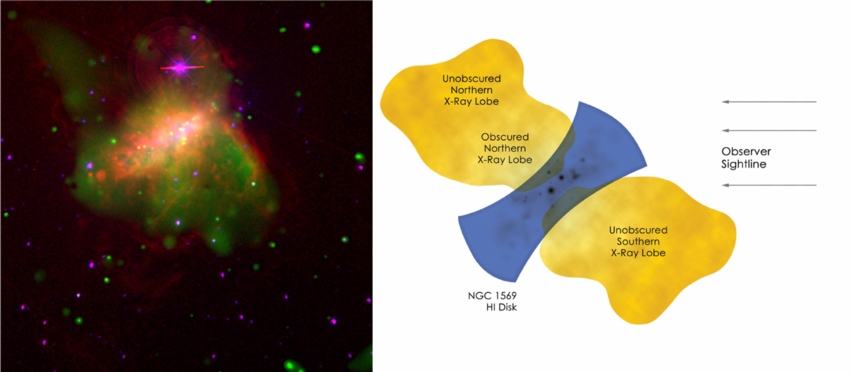
 Credit: NASA/UCSB/C.Martin et al. & NOAO/KPNO/C.Martin; CXC/M.Weiss
Credit: NASA/UCSB/C.Martin et al. & NOAO/KPNO/C.Martin; CXC/M.Weiss
Dwarf's Gift
Stars produce the chemical elements important for life. In galaxies, stars seed
the interstellar medium with oxygen, silicon, magnesium, nitrogen, and other
elements (which astronomers call "metals") necessary for life. An open question
is whether and how galaxies themselves can pollute the space between galaxies
with these elements. A new
observation by the Chandra X-ray
Observatory has shown how this process might be done. The image on the left
above shows a composite X-ray and optical image of the dwarf galaxy NGC 1569.
This galaxy is undergoing a burst of star formation and as these stars explode
as supernova they produce metals which get ejected into space; because this is a
dwarf galaxy, it's relatively easy for this fast-moving ejecta to escape the
into intergalactic space. The green color shows X-rays from multimillion degree
Celsius gas heated by shock waves extending for large distances away from the
galaxy. Chandra shows that this gas is enriched in metals, containing (for
example) an amount of oxygen quivalent to 3 million suns. The red color shows
the optical light from warm gas heated by the ultraviolet light from massive
stars. Large loops of the warm gas can be seen extending above and below the
disk of the galaxy. The picture on the right shows the orientation of NGC 1569
and its X-ray emitting lobes and the observation direction.
Last Week *
HEA Dictionary * Archive
* Search HEAPOW
* Education
Each week the HEASARC
brings you new, exciting and beautiful images from X-ray and Gamma ray
astronomy. Check back each week and be sure to check out the HEAPOW archive!
Page Author: Dr. Michael F. Corcoran
Last modified July 29, 2002


